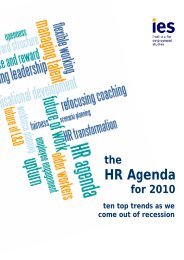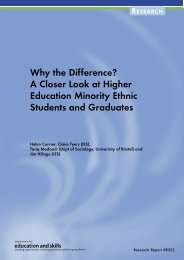Post-16 Transitions: a Longitudinal Study of Young People with ...
Post-16 Transitions: a Longitudinal Study of Young People with ...
Post-16 Transitions: a Longitudinal Study of Young People with ...
You also want an ePaper? Increase the reach of your titles
YUMPU automatically turns print PDFs into web optimized ePapers that Google loves.
change has been in the structure <strong>of</strong> the youth labour market.<br />
After the post-Second World War boom, the English<br />
manufacturing industry, in common <strong>with</strong> that in many parts<br />
<strong>of</strong> the ‘developed’ world, went into a significant decline and<br />
the balance <strong>of</strong> industrial composition shifted markedly from<br />
manufacturing to service industries (Lindsay, 2003). This in<br />
turn had implications for rising unemployment, increasing<br />
labour market ‘flexibility’ (such as part-time employment) and<br />
declining male participation in the workforce. There were<br />
particular implications for young people. Whilst employment<br />
generally grew in this period, youth unemployment rose<br />
spectacularly; from 1960 when the unemployment rate for<br />
under-25s was between two and three per cent, the figure had<br />
risen to over 21 per cent by the early 1980s (Coles, 1995). As a<br />
result, young people delayed their entry into the labour<br />
market and instead became more likely to follow the<br />
education and training pathways, by staying on at school,<br />
entering further education or participating in a range <strong>of</strong><br />
vocational training schemes. Whereas in the late 1970s nearly<br />
half <strong>of</strong> <strong>16</strong>-year olds entered the labour market directly, by the<br />
late 1990s, this figure had shrunk to ten per cent (Pearce and<br />
Hillman, 1998).<br />
Currently, therefore, young people are much more likely than<br />
their predecessors to have what Coles (1995) calls ‘extended’<br />
or ‘fractured’ transitions. At best, more young people are<br />
likely to find themselves spending substantial periods <strong>of</strong> time<br />
in education and training after the end <strong>of</strong> statutory schooling,<br />
before finally entering the labour market in their late teens or<br />
early twenties. They may, during this time, be making steady<br />
progress in terms <strong>of</strong> skills, knowledge and accreditation, but<br />
there are, <strong>of</strong> course, implications in the meantime for their<br />
capacity to live independently and achieve other markers <strong>of</strong><br />
adulthood. At worst, however, young people find themselves<br />
in a ‘magic roundabout’ situation (Roberts, 1995). They are<br />
retained in repeated cycles <strong>of</strong> training <strong>with</strong> little obvious<br />
progression, becoming unemployed, or moving episodically<br />
between spells <strong>of</strong> training, spells <strong>of</strong> short-term employment<br />
and spells <strong>of</strong> unemployment. Again, the implications for their<br />
capacity to live independently, grow in maturity, establish<br />
stable relationships and become active citizens may be<br />
significant.<br />
2.2 Policy responses<br />
Successive governments have responded to this changing<br />
situation in two broad ways. First, they have increased the<br />
opportunities and incentives for young people to follow the<br />
education and training pathways by expanding further and<br />
higher education and encouraging the development <strong>of</strong> a range<br />
10 <strong>Post</strong>-<strong>16</strong> <strong>Transitions</strong> <strong>of</strong> <strong>Young</strong> <strong>People</strong> <strong>with</strong> SEN: Wave 2

















